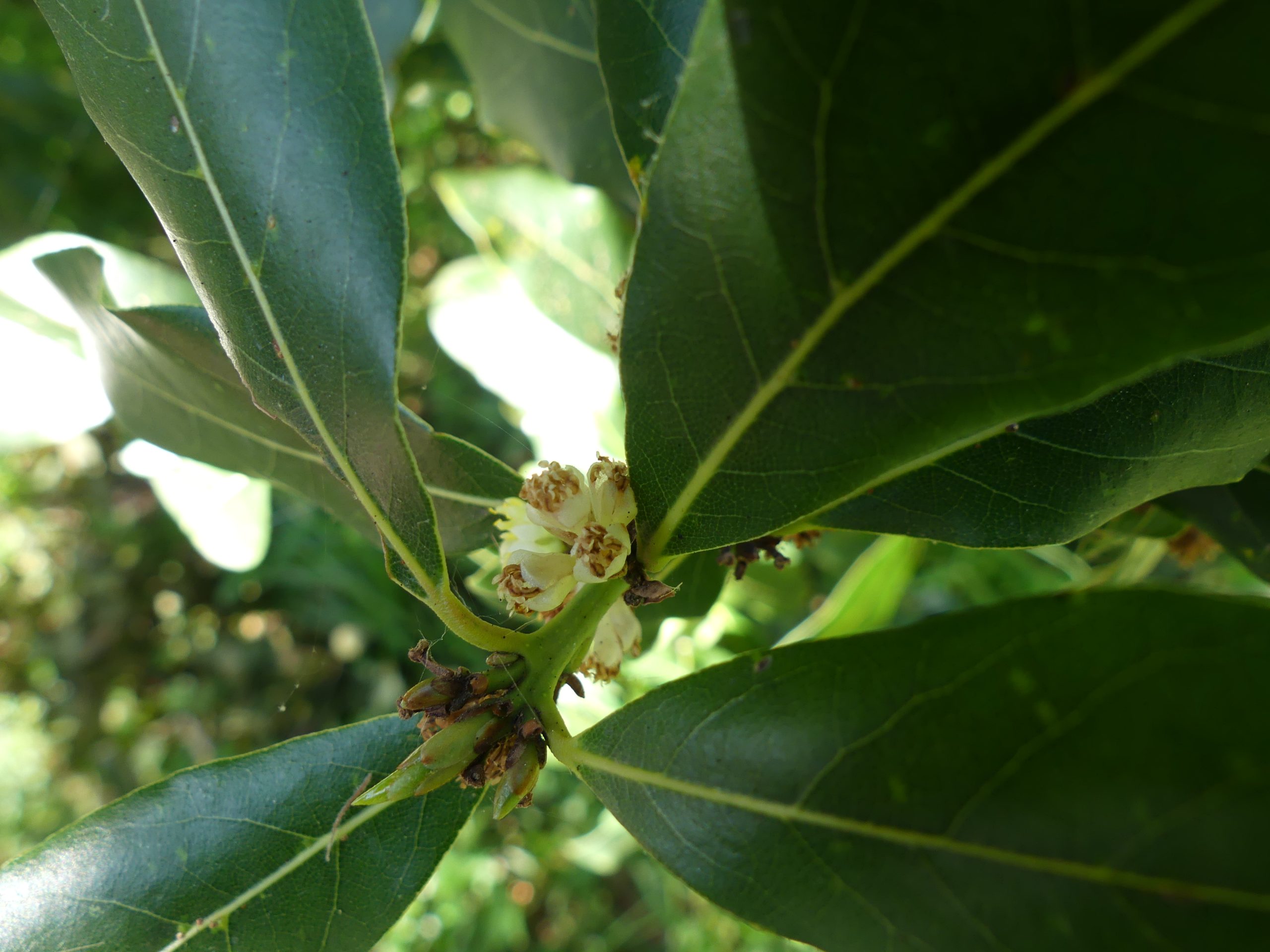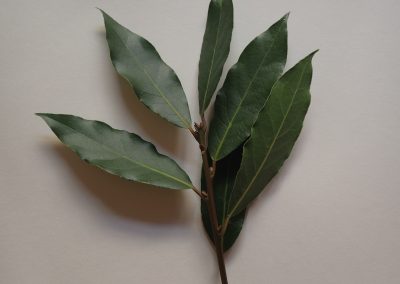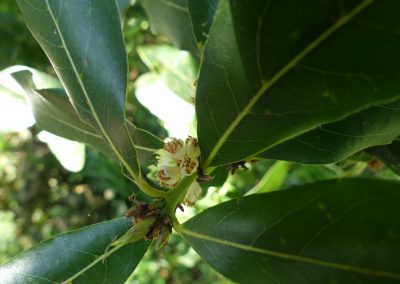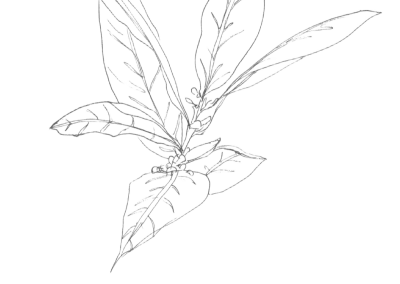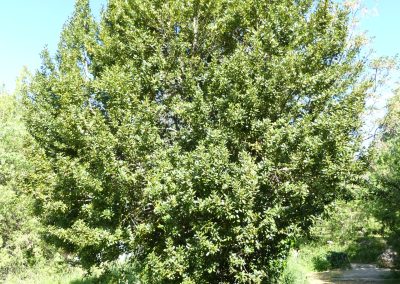Laurus nobilis
Scientific description
Taxon: Laurus nobilis
Class: Dicotyledons (Magnoliopsida)
Subclass: Magnoliids
Order: Laurales
Family: Lauraceae
Common name: Bay laurel / Sweet bay
Origin:
Mediterranean region.
Description:
Evergreen shrub or small tree up to 10 m. Lanceolate, leathery, dark green, glossy, aromatic leaves. Smooth gray bark. Flowers in spring, small yellowish in umbels; dioecious species. Fruit a small black ovoid drupe. Typical of Mediterranean maquis, drought-resistant, grows on well-drained soils. Cultivated for ornamental and culinary use.
Propagation:
Seeds (slow germination), semi-hardwood cuttings, or layering.
Ecology:
Understory species in Mediterranean forests, tolerant of partial shade. Attracts pollinating insects.
Uses:
Leaves as culinary seasoning. Essential oil for perfumery and personal care. Hard wood used in woodturning.
Threats:
Not globally threatened; locally vulnerable to wildfires and urban expansion. Can be affected by fungal diseases (e.g., Phytophthora).
Taxon : Laurus nobilis
Classe : Dicotylédones (Magnoliopsidées)
Sous-classe : Magnoliidées
Ordre : Laurales
Famille : Lauracées
Nom commun : Laurier noble
Origine :
Région méditerranéenne.
Description :
Arbuste ou petit arbre persistant jusqu’à 10 m. Feuilles lancéolées, coriaces, vert foncé, brillantes et aromatiques. Écorce lisse grise. Floraison au printemps, petites fleurs jaunâtres en ombelles; espèce dioïque. Fruits drupes noires ovoïdes. Plante typique du maquis méditerranéen, résistante à la sécheresse, pousse sur sols bien drainés. Cultivée pour usage ornemental et culinaire.
Propagation :
Par graines (germination lente), bouturage semi-ligneux ou marcottage.
Écologie :
Espèce de sous-bois méditerranéen, tolère l’ombre partielle. Attire insectes pollinisateurs.
Utilisation :
Feuilles comme aromate. Huile essentielle pour parfumerie et soins. Bois dur utilisé en tournage.
Menace :
Non menacé globalement; vulnérable localement aux incendies et à l’urbanisation. Peut être affecté par maladies fongiques (ex. Phytophthora).
Taxon: Laurus nobilis
Clasă: Dicotiledonate (Magnoliopsida)
Subclasă: Magnoliide
Ordin: Laurales
Familie: Lauraceae
Denumire populară: Dafin / Laur nobil
Origine:
Regiunea mediteraneană.
Descriere:
Arbust sau arbore mic, veșnic verde, până la 10 m. Frunze lanceolate, coriacee, verde închis, lucioase, aromatice. Scoarță netedă, gri. Înflorire primăvara, flori mici gălbui în umbele; specie dioică. Fruct drupe negru ovoidal. Tipic maquis mediteranean, rezistent la secetă, crește pe soluri bine drenate. Cultivat ornamental și culinar.
Propagare:
Semințe (germinare lentă), butași semilemnoși sau marcotaj.
Ecologie:
Specie de subpădure mediteraneană, tolerează umbra parțială. Atrage insecte polenizatoare.
Utilizare:
Frunze ca aromatizant culinar. Ulei esențial pentru parfumuri și îngrijire personală. Lemn dur folosit în strunjire.
Amenințări:
Nu este amenințat global. Vulnerabil local la incendii sau urbanizare. Poate fi afectat de boli fungice (ex. Phytophthora).
Ταξινόμηση: Laurus nobilis
Κλάση: Δικοτυλήδονα (Magnoliopsida)
Υποκλάση: Μαγνολίδες
Τάξη: Laurales
Οικογένεια: Δάφνιες (Lauraceae)
Κοινή ονομασία: Δάφνη / Ευγενής δάφνη
Προέλευση:
Μεσογειακή περιοχή.
Περιγραφή:
Αειθαλής θάμνος ή μικρό δέντρο έως 10 μ. Λογχοειδή, σκληρά, σκουροπράσινα, γυαλιστερά, αρωματικά φύλλα. Λείος γκρι φλοιός. Ανθίζει άνοιξη, μικρά κιτρινωπά άνθη σε σκιάδια; δίοικο είδος. Καρποί μικρές μαύρες ωοειδείς δρύπες. Τυπικό φυτό μακκί, ανθεκτικό στην ξηρασία, αναπτύσσεται σε καλά στραγγιζόμενα εδάφη. Καλλιεργείται και για διακοσμητική και μαγειρική χρήση.
Διάδοση:
Σπόροι (βραδεία βλάστηση), ημιξυλώδη μοσχεύματα ή καταβολάδα.
Οικολογία:
Είδος υπόροφος σε μεσογειακά δάση, ανεκτικό στη μερική σκιά. Έλκει επικονιαστικά έντομα.
Χρήσεις:
Φύλλα ως αρωματικό στη μαγειρική. Αιθέριο έλαιο για αρώματα και καλλυντικά. Σκληρό ξύλο χρησιμοποιείται στην ξυλουργική και στρογγυλοποίηση.
Απειλές:
Δεν απειλείται σε παγκόσμιο επίπεδο. Τοπικά ευάλωτο σε πυρκαγιές ή αστικοποίηση. Μπορεί να προσβληθεί από μυκητολογικές ασθένειες (π.χ. Phytophthora).
Creative writing inspired by Laurus nobilis
Noble laurel
The cool, damp weather was perfect for getting some fresh air and going for a walk in the forest. As I strolled through the forest, filled with the scents and colors of autumn, I suddenly saw a blue-and-white bird alight on a magnificent plant.
As I approached the plant, I could see that it was a noble laurel.
The noble laurel is not only good for health, but also for cooking. It is also used to create essential oils.
This laurel has specific symbols such as beauty, victory and vitality.
So I decided to cut off a piece and cook myself a nice hot meal on the way home from this wonderful walk.


